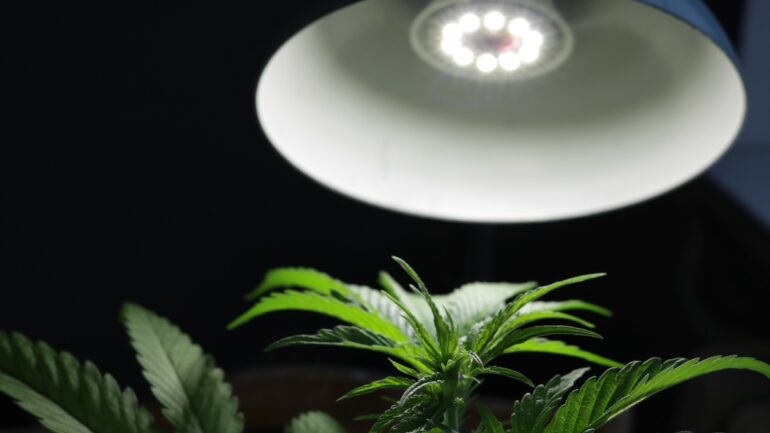PHC, aka hydrox4phc or hydrox-4-PHC, is a very new, semisynthetic hemp derivative. It is already available for retail consumers, but there are many health and safety questions left unanswered since there’s no animal or human research behind it.
PHC is functionally similar to THC in that it causes a high, so we can only presume that CB1 and CB2 receptors are activated by PHC.
Recreational use of PHC is legal and theoretical medical use is possible, but the safety questions loom too large to be ignored. The degree to which PHC uniquely has or shares any benefits or adverse effects with THC is entirely unknown.
What We Know About PHC
The first of many unknowns I encountered when researching PHC is in its name and structure. We don’t even know what PHC really stands for. “Hydrox4phc” doesn’t share any familiarity or recognized naming conventions established with phytocannabinoids (plant-based cannabinoids) that could give us more clues about its behavior.
To our knowledge, PHC is also not a replica of any minor phytocannabinoid, such as with delta-8 THC. We know this since PHC has never been confirmed in any publication as a natural cannabis constituent, nor as a synthetic one. This leaves us in the dark about its chemical structure and what molecular targets it may have besides CB1 and CB2 receptors.
According to manufacturers, PHC starts with semisynthetic conversion of hemp-based CBD into THC-O-Acetate, and then into PHC. This is as much as they’ve shared, along with some vague lab results reporting over 90% delta-8 THC in PHC products, while foreign matter is not tested, raising quality and purity concerns.
Potential Medical Benefits
We only know the bare bones of PHC, including that it is: 1) psychoactive; 2) non-naturally occurring, and 3) made from further processing of THC-O-Acetate which is another semisynthetic hemp derivative of CBD.
Manufacturer reports cite a “99%” conversion to THC, without any published data to prove it. This is hard to believe, since even natural THCA, which directly converts into THC, only does so with a 70% efficiency under optimal conditions.
Notwithstanding a lack of peer-reviewed papers, if these assertions are true then PHC could potentially be used similarly to THC for:
- Chronic pain
- Nausea and vomiting
- Muscle spasms
- Seizures and epilepsy
- Symptomatic relief of various neuropsychiatric conditions
Health Risks
The handful of manufacturers who create PHC products haven’t released any specific details about exactly how PHC is made, what the chemical formula looks like, metabolism, pharmacokinetics, safety, or any health information about it.
Consumers should know they are leaving these health and quality matters entirely in the producers’ hands. Potential risks include:
- Euphoria or dysphoria
- Paranoia
- Dry mouth
- Red and dry eyes
- Dizziness
Choosing PHC vaping or an inferior quality product may result in serious health consequences, such as:
- Vomiting
- Hallucinations
- Trouble standing
- Respiratory distress (including EVALI)
- Loss of consciousness
Will PHC Get You High?
Yes, and this is just about the only biological effect we can ascertain about PHC. Manufacturers will claim it has the same potency as THC but with a longer duration.
Still, the lack of pharmacokinetic studies means we don’t know exactly how strong a PHC high is, partial or full CB1 agonism (like THCP), or comparison to delta-9, delta-8, and other psychoactive cannabinoids.
Conclusion
If you choose to approach PHC, understand that it may be risky for short and long-term health in ways we don’t know yet. Heavy caution must be exercised.
References
- Benowitz, N. L., Havel, C., Jacob, P., O’Shea, D. F., Wu, D., & Fowles, J. (2023). Vaping THC-O Acetate: Potential for Another EVALI Epidemic. Journal of Medical Toxicology: Official Journal of the American College of Medical Toxicology, 19(1), 37–39. https://doi.org/10.1007/s13181-022-00921-3
- Benowitz, N. THC-O Acetate linked to severe lung disease. (2021) Center for Tobacco Control Research and Education. Retrieved November 27, 2023, from https://tobacco.ucsf.edu/thc-o-acetate-linked-severe-lung-disease
- Ebbert, J. O., Scharf, E. L., & Hurt, R. T. (2018). Medical Cannabis. Mayo Clinic Proceedings, 93(12), 1842–1847. https://doi.org/10.1016/j.mayocp.2018.09.005
- Geci, M., Scialdone, M., & Tishler, J. (2023). The Dark Side of Cannabidiol: The Unanticipated Social and Clinical Implications of Synthetic Δ8-THC. Cannabis and Cannabinoid Research, 8(2), 270–282. https://doi.org/10.1089/can.2022.0126
- Guo, W., Vrdoljak, G., Liao, V.-C., & Moezzi, B. (2021). Major Constituents of Cannabis Vape Oil Liquid, Vapor and Aerosol in California Vape Oil Cartridge Samples. Frontiers in Chemistry, 9. https://www.frontiersin.org/articles/10.3389/fchem.2021.694905
- Holt, A. K., Poklis, J. L., & Peace, M. R. (2022). ∆8-THC, THC-O Acetates and CBD-di-O Acetate: Emerging Synthetic Cannabinoids Found in Commercially Sold Plant Material and Gummy Edibles. Journal of Analytical Toxicology, 46(8), 940–948. https://doi.org/10.1093/jat/bkac036
- CDC Health Alert Network. 2021. Increases in Availability of Cannabis Products Containing Delta-8 THC and Reported Cases of Adverse Events. CDC PDF.
- Moreno-Sanz, G. (2016). Can You Pass the Acid Test? Critical Review and Novel Therapeutic Perspectives of Δ9-Tetrahydrocannabinolic Acid A. Cannabis and Cannabinoid Research, 1(1), 124–130. https://doi.org/10.1089/can.2016.0008
- Sarma, N. D., Waye, A., ElSohly, M. A., Brown, P. N., Elzinga, S., Johnson, H. E., Marles, R. J., Melanson, J. E., Russo, E., Deyton, L., Hudalla, C., Vrdoljak, G. A., Wurzer, J. H., Khan, I. A., Kim, N.-C., & Giancaspro, G. I. (2020). Cannabis Inflorescence for Medical Purposes: USP Considerations for Quality Attributes. Journal of Natural Products, 83(4), 1334–1351. https://doi.org/10.1021/acs.jnatprod.9b01200
- Shahbazi, F., Grandi, V., Banerjee, A., & Trant, J. F. (2020). Cannabinoids and Cannabinoid Receptors: The Story so Far. iScience, 23(7), 101301. https://doi.org/10.1016/j.isci.2020.101301
